Fireweed: A symbol of hope for our regenerative future
How Fireweed brought us hope during an Idaho bike-packing trip that got cut short by fire and smoke
What a special trip… Bike-packing-fly-fishing the Sawtooth mountains of Idaho with my only blood brother, sister, and dad- together, wandering streams, creeks, meadows and forests, seeking glimpses of beautiful views and those special silvery streaks of trout and whitefish, thrillingly finding the correct lure to entice. A top-notch American Adventure that many of us dream of.

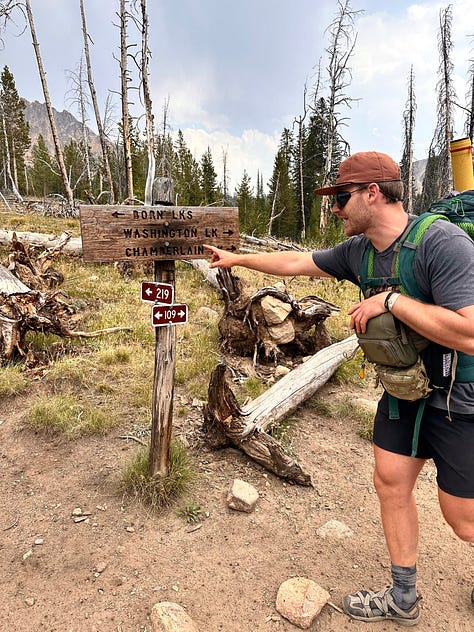
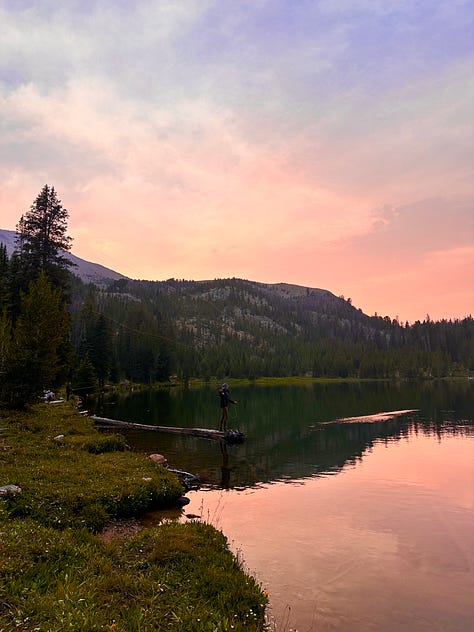
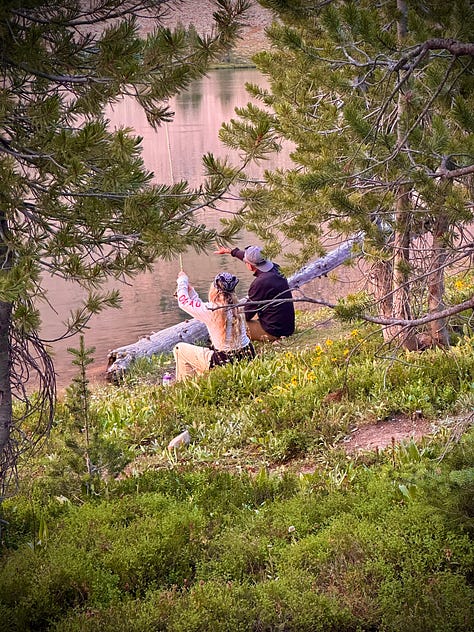
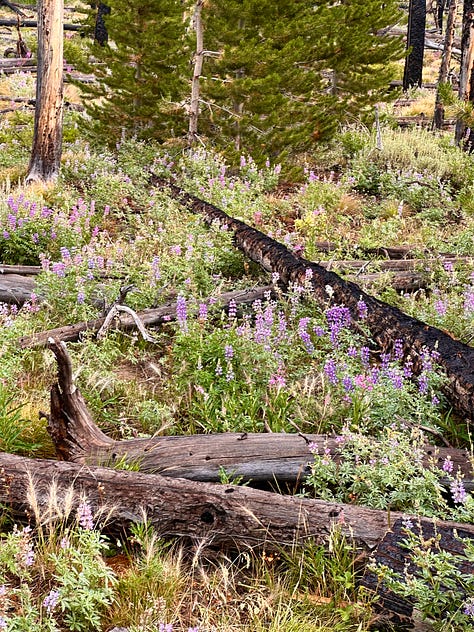
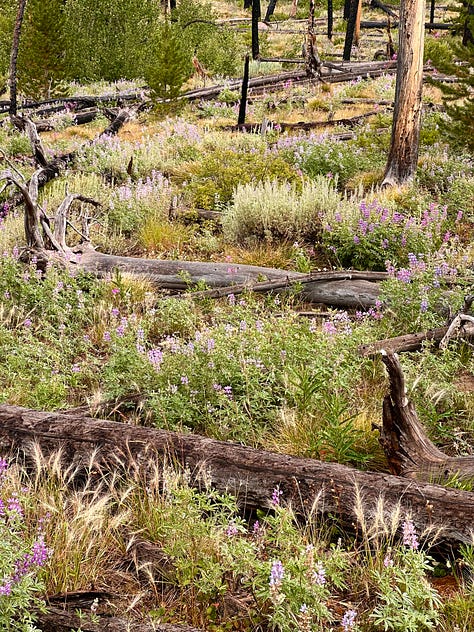
Cameron, my brother, our guide, took us up and down the Sawtooths, on bikes and foot, from lakes to creeks, dredges and meadows, a splendor trip full of sunrises and smoky sunsets. Little did we know that those smoky sunsets were an omen of our trip’s premature demise. Naive of this outcome, we rejoicingly jumped into icy alpine lakes and rivers, wandered trails, biked and camped, ate excellently, slept better than you should in tents. Someday I want to tell you about the grandfather tree I slept under… Really, we have so many stories to tell you about this trip, like our friend Giselle, the deer, who stayed with us all night - but for now, I want to tell you the story of Fireweed, this magenta magnate, beacon of hope in a literally burning world.
The omnipresence of Fireweed - throughout history
The Tlingit tribe of the north eastern coast of the United States, who wandered and do still wander meadows of fireweed, tell the story of Astinmah, the first Woman, who wove a blanket from fireweed fibres. She went to the four directions with that blanket, spreading it over the whole Earth. Sitting on the edge of the blanket, she wove songs into the blanket, easing the birth pains of Earth until the first animals came forth.
Reaching back throughout history, deep into ancient memory, Chamerion angustifolium, known commonly as Fireweed, has graced our forests and meadows: Our burnt places and our ruined places, for millennia. Your ancestors, too, wandered along mountainsides dashed with highlights of magenta from this magical wildflower. Your ancestors and mine, yes, because Fireweed is native to practically everywhere In the northern hemisphere!
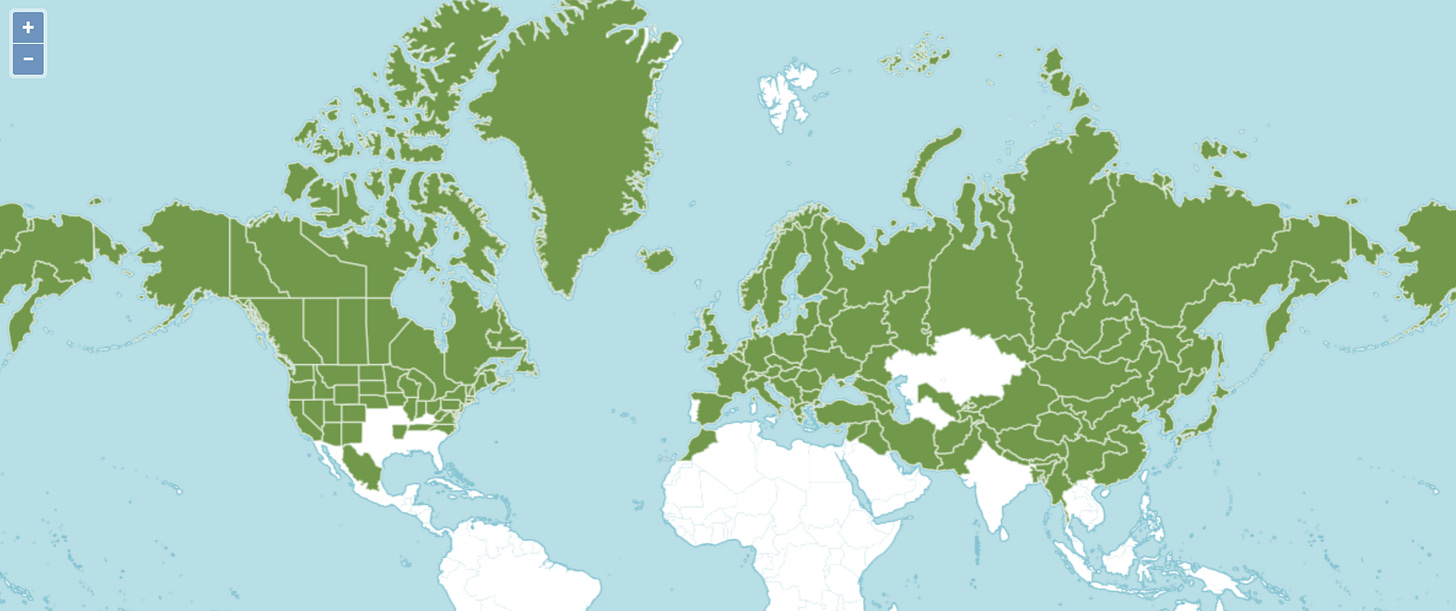
This special wildflower, Fireweed, to me is a world-wide symbol of nature’s regenerative ability. Many of you may already know that Fireweed is so named for its miraculous appearance along wildfire-ruined forests. But did you also know that it is known to regenerate the soils of deforested spaces from logging, mine waste, roadsides, and waste areas? If there is anything to learn about our role on this planet in inviting nature back into our spaces, I think Fireweed has a lot to say, a lot to stand for, and a lot to teach us.
Every fireweed is the soul of a tree lost in a forest fire. -Native legend
The symbol of Fireweed’s regeneration
I believe this beautiful wildflower, native to so many homes, is a benevolent beacon and symbol of hope for us and nature: Her ability to regenerate this planet, and our ability to encourage it, facilitate it. I think we have so much to learn from Fireweed, and there is so much about her that can inspire our minds and souls to undergo a courageous journey of regenerating what we have taken and what we continue to take. We have a responsibility and a power, you see, a magnificent opportunity to use our environmental engineering ability, to give back to her, and replenish this world - burnt and ransacked - with meadows of fireweed and natural diversity. The same power we use to take away from, remember, is the same power we have to give back.
Kicked out by fire and smoke
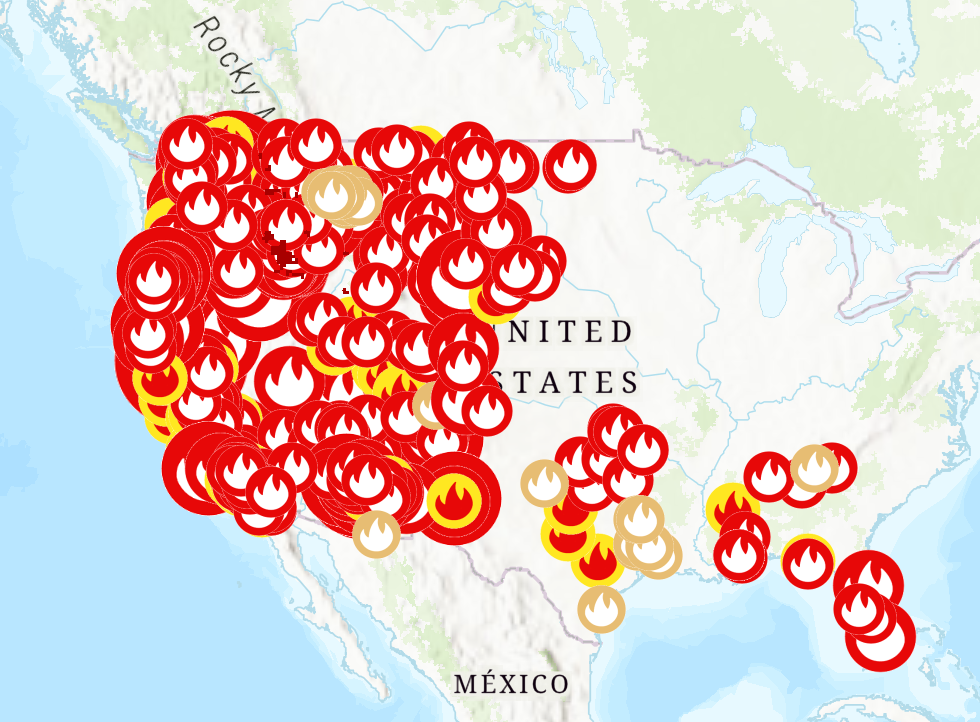
The final morning of our trip, meant to be our 5th of 7 days in the Sawtooths, was serene. Breakfast, fishing, resting on a gentle meandering river-meadow. Then, out of nowhere, while I hammocked peacefully, wind and smoke, came pouring torrentially into our noses and throats, burning and congesting at once. Watching cars speed away back up a bumpy dirt road, we found out from Starlink that there was a new wildfire 20 miles east of us. Cameron, our fearless guide, already a bit sick from a steak dinner the previous night, helped us decide that it was time to pack up and run - much to our dismay.
Leaving behind that quiet meadow full of life, imagining it being engulfed in flame hours later, the birds, deer, and chipmunks we were recently playing with, dashing in terror… Left me choking on emotion, not just smoke.
Yes, it’s dire out there, admitting and accepting that is the first step toward recovery and regeneration
Grieving is necessary: when there is real loss, grieving should never be avoided or postponed; grieving is absolutely necessary. Without grief the world would cease to renew itself; the world would cease to exist.
-Martin Prechtel, The Smell of Rain on Dust
Pulling away from our quiet meadow and driving through the scars of recent fires was a devastating blow to our hearts. Such a fun adventure torn to pieces by a force beyond our control. None of us remember growing up worrying about wildfires in the wild, nor hearing our parents tell stories of growing up, fearful of wildfires -we could only recall stories of bears and scares from mysterious tent visitors… But not wildfires.
During our trip, we noted a profound lack of wildlife, very few friends, very few fish. And those very few friends… behaving strangely (a la Giselle, the story for another time). If you look at a map right now, in fact Google Maps now has a WILDFIRE feature… which speaks to their new commonality… you can see the devastation, live. I don’t, frankly, know how or why this is happening, but I can tell you that the forests of your memories, are burning in the United States and Canada and it is heart-breaking and happening at an alarming rate that I don’t think enough of us are talking about.

Enter Fireweed
Chamerion angustifolium is in the Onagraceae, evening primrose family. Three different genus names are associated with fireweed, Epilobium, Chamaermerion, and Chamerion. Blooming magenta flowers between June and September, fireweed stalks can grow 1-6 feet, sometimes known to reach 9 feet under the right circumstance! Once blooming season is over and the plant has pollinated, seeds become delightful cotton tufts, characteristic of fall. These cotton tufts represent an impressive (and sometimes overwhelming) ability to spread and broadcast broadly over large areas.
Fireweed shows great potential for use in forest reclamation as it is capable of germinating and growing on reclaimed soils. It is effective in taking up nutrients from the soil, promoting nutrient capture, accumulation, and likely nutrient cycling on newly reclaimed sites (Pinno et al. 2014). Severe fires burn up organic soil layers, leaving mineral soil exposed. This is the kind of seedbed fireweed seeds are said to favor. Research has shown that fireweed grown in soil with pH 3.5, it was found to produce 80 percent fewer seeds than when grown in a 5 pH soil. And it does grow in neutral soils.
Fireweed kicks off post-fire land restoration in two ways: via widely spreading, fast-growing rhizomes and via seeds. The rhizomes have been waiting patiently, even for decades, in the soil of a mature forest for the next fire. (You may not even know fireweed is there if the forest canopy is closed.) Most of the rhizomes are within two inches of the soil surface (some say six inches), though they have been found over a foot deep. It is said the rhizomes are able to survive at least a medium-intensity fire depending on how close to the surface they are and how intense the fire. Certainly we have seen it after high-intensity conflagrations such as the Mt. Helens volcano eruption, the 1988 Yellowstone fires and wildfires local to us. Rhizomes can begin growing at 40 degrees Fahrenheit. The new shoots can bloom within 20 to 30 days after a canopy-clearing fire. The more the rhizomes are fragmented, the more shoots pop up, covering the burn in dense stands.
The second restoration strategy is via its seeds, which explode in profusion from these new shoots. They may be blown to an area with or without fireweed rhizomes.
Some land managers say fireweed is the most useful forb for restoration in the montane. It stabilizes soils and grows effectively on reclaimed soils. It is seeded to revegetate mined lands. Sometimes it doesn’t wait to be asked: “Fireweed voluntarily seeded into plantings of commercial species on coal strip mines in Alaska.” “Fireweed formed mycorrhizal associations on coal mine spoils.” (USFS Fire Effects Information System)
Fireweed excels at nutrient capture, accumulation, and cycling on newly reclaimed sites. “Its tiny seedlings and rhizomes reach deep, even crack through rocks to pull minerals up from deep within the earth” (University of Colorado at Boulder Museum of Natural History). It takes up and recycles significantly more nutrients such as potassium, magnesium, manganese, phosphates, and zinc from burned areas than unburned ones. Fireweed represents a part of a growing interest in “phytoremediation” - leveraging nature’s ability to extract waste materials via plants natural ability to transmutate materials and nutrients, including heavy and toxic metals. More on that later, perhaps.
Fireweed’s honeybee pollinators turn its abundant nectar into honey, popular in Alaska and a big player in the Canadian honey market. In the former Soviet Union, beekeepers have kept their hives on the move from one freshly logged area to the next, ensuring prodigious fireweed nectar for their bees. Pounds of honey obtained were reported to be as high as 892.2 per acre (1,000 kg/ha).
Each Fireweed flower is perched at the end of its fruit, a long, narrow capsule containing 300-500 seeds. The seeds are very tiny, approximately 6,800,000 per pound. Just one fireweed plant alone can produce 80,000 seeds per year!
The wind catches the tuft of long silky hairs at one end of the seed and bears it high aloft, sometimes up to 200 miles away. What brings them down to earth? They sense humidity, which causes the plume to contract and descend.
Almost one hundred percent of newly collected fireweed seeds are said to germinate within 10 days in warm, moist conditions in a variety of temperatures 40 degrees Fahrenheit or over.
“When fireweed turns to cotton, summer will soon be forgotten.”
Fireweed’s Beacon of Hope
Fireweed reminds me that, though, things get destroyed, nature has embraced this cycle of physical existence. Life is both chaos, destruction, but also growth and beauty. Fireweed teaches us that there is ALWAYS something we can do under any circumstance, no matter how dismaying. I think that as a society, we take a lot from nature, perhaps too much- but I think that same power to take away represents the same power we have to GIVE BACK to nature. I think we have a magnificent ability to restore and regenerate our world, to choose a new path, a new relationship with the earth. And I think we can use the Fireweeds of the world to regenerate what we have taken, to regenerate the destruction. I take great hope and faith in the idea that by spreading Fireweed, spreading wildflowers, spreading those things that will help regenerate this world - spending our money and resources on regenerative commodities - we can turn the tide of our direction and presence on this planet.
Let’s take a moment and consider the lessons of Fireweed, let’s take hope, let’s spread some seed, ushering in a new era of Fireweed’s regeneration. Let’s invite nature back into our spaces, back into our lives. Let’s stop borrowing her, taking from her less, and wrecking her with our ways. Let’s regenerate that which has burned, let’s re-grow that which we have torn down.
With all my heart, let’s regenerate this world.
On the breeze my fluff is blown;
So my airy seeds are sown.
Where the earth is burnt and sad,
I will come to make it glad.
All forlorn and ruined places,
All neglected empty spaces,
I can cover—only think!—
With a mass of rosy pink.
Burst then, seed-pods; breezes, blow!
Far and wide my seeds shall go!
On Fireweed (Rose-bay Willow-herb) from “Flower Fairies of the Wayside” by Cicely Mary Barker, 1974
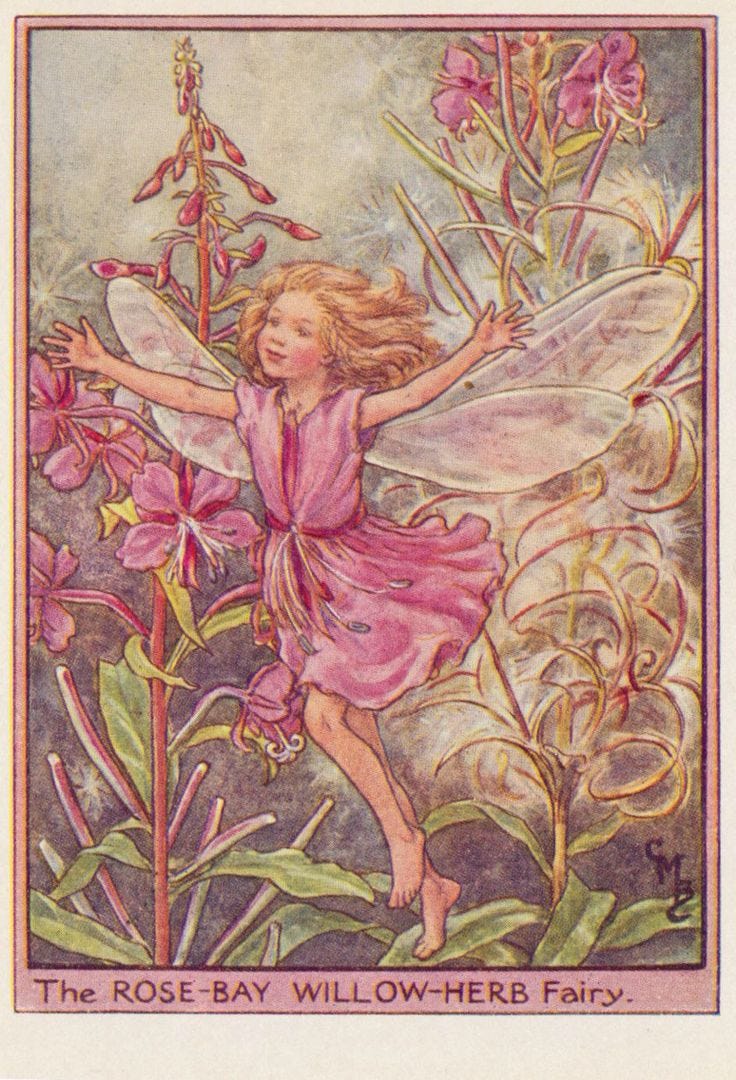
Sources:
https://khkeeler.blogspot.com/2019/12/plant-story-iconic-fireweed.html
https://powo.science.kew.org/taxon/urn:lsid:ipni.org:names:92411-2
https://flowerfairies.com/rose-bay-willow-herb-fairy/
https://www.westernnativeseed.com/plant%20guides/chaangpg.pdf





Hi Bryan! Long time no see. I’m so glad you guys are all safe! That sounds like a scary end to an amazing trip.
I find myself constantly vacillating between hope and grief over the natural world. When we were deciding where to look for jobs toward the end of Brennan’s residency we really wanted to come back west but I was really worried about smoke filled summers. Then the summer of 2022 wildfires got so bad we had smoke in all the way down in Richmond, Virginia from Canadian fires and I knew it didn’t matter where we lived, the climate crisis would affect us in some way. And now I am in a place mentally where I’m not longer trying to avoid it but to do what I can to tip the scales of cultivation and extraction to one that provides more than takes. I’m sure I’m failing spectacularly.
I fell in love with and gleaned hope from fireweed at Mount Spokane this summer but I did not realize just how regenerative to the soil it is—even in old mining areas, that’s amazing! We visited the redwoods in June and seeing the burn scars on those ancient giants also filled me with hope. They have evolved to endure so much and I really think/hope they’ll endure all we’ve done to harm their home.
Beautiful imagery! It seems such a strange reality we have created for ourselves today. We maximize comfort and security - yet, ironically, I believe living comfortably and secure compromises much more important virtues. A fake promise of security can rob us of liberty - so is such security actually security? We must find ways to push out of the boxes that years of industrial progress have created. The substrate of great community is hard work. Love the thoughts that fireweed inspires!!